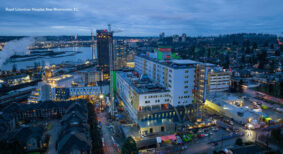Safety considerations are critical in any aspect of construction, but they are especially important when navigating the most dangerous situations. Along with slips and trips, falls are some of the most common causes of workplace injuries and fatalities in the construction industry.
The Canadian Centre for Occupational Health and Safety reports at least 60,000 workers deal with injury from slips, trips and falls each year. Not only is this saddening from a humanitarian perspective, but one incident can cost an average of $3,500 in direct costs and thousands more in the indrect costs of downtime and legal expenses.
Given the potential for danger, professionals in the construction industry must implement procedures and strategies that minimize injuries and fatalities from falls. This article will provide construction safety tips for operating at height.
5 Tips for Working at Height
Prioritizing safety is as critical during elevated work as it is when operating heavy equipment, working near traffic, or removing hazardous materials. Following these tips will ensure a safe working environment when performing construction work at height.
1. Know the Risks
The first step to promoting workplace safety is understanding the risks. Crew leaders should consider a few factors when assessing fall risks.
It is essential to know how much elevated work will be necessary to complete a project and how high workers will be elevated. This information will help project planners allocate the required resources for worker safety.
Additionally, decision-makers should inspect the areas where elevated work will take place. Any slick, cluttered, or uneven surface at a high elevation exacerbates the risk of a harmful fall.
2. Know the Regulations
The Canadian Centre for Occupational Health and Safety (CCOHS) sets construction industry fall protection standards to minimize injuries and fatalities. Understanding and applying CCOHS protocols will help you prevent dangerous accidents on your job site.
CCOHS requires construction crews to use fall protection when operating on or constructing any elevated surface or near a hole if they could fall 3 metres or more. Fall protection may include systems such as guardrails, safety nets, or personal arrest equipment.
3. Make a Plan
After understanding the hazards and regulations that apply to an elevated work site, it is necessary to implement a risk-reduction plan.
Before machines are even in use, checks should be in place to maintain good working condition. Operators should inspect equipment for fluids and proper tire pressure, then flag any belts or components that show signs of wear.
In cases where working at height is essential, crew leaders should plan to mitigate risk and comply with regulations. Risk reduction strategies may include:
- Utilizing safety equipment such as harnesses, ladders, guardrails, and scissor lifts.
- Implementing equipment inspection and maintenance procedures.
- Requiring supervision when working at height.
- Requiring assistance when using safety equipment.
- Using fall detection devices when working alone.
- Operating from locations or surfaces known to be safe.
- Clearing all elevated surfaces of tripping hazards.
- Establishing a clear emergency response plan.
4. Communicate With the Team
To prevent workplace falls, team leaders should establish a culture that prioritizes safety. Develop a safety-first culture through the communication of safety policies and procedures.
All employees should know the safety regulations that apply, why they are necessary, and how they can meet them. Crew leaders are responsible for communicating safety requirements through training sessions.
Safety regulators typically require employers to provide a training program for employees who may work at height. The training should cover topics such as the types of fall hazards, how to set up and use fall hazard protection, and each employee’s role in a fall protection plan.
5. Monitor Performance
Ensuring workplace safety is an ongoing effort. Fall safety training should occur at every new job site so that workers understand the unique risks that apply to the setting.
Additionally, crew leaders should assess employee performance as it relates to fall safety procedures. Recognizing and correcting areas in which crew members fail to meet safety standards can prevent a serious injury or fatality.
Construction leaders can monitor and improve a crew’s safety performance by following the statistical framework that presenters established at the 55th Annual Associated Schools of Construction International Conference.
The framework involves establishing safety indicators, monitoring the workers and work environment for adherence to the safety indicators, and correcting any unsafe practices or conditions.
Finally, the development of new technologies for worksite safety opens up new opportunities to monitor workers and improve safety. Smart sensors and wearable technologies can help flag concerns like fatigue, raising awareness around human vulnerabilities.
Apply Basic Fall Safety Principles to Ensure Workplace Safety
Falls are among the most common and harmful incidents on construction sites. Prevent injuries and fatalities from falls by identifying risks on each job site, understanding regulations that protect workers, developing a fall safety plan, training workers to implement the fall safety plan, and actively monitoring fall safety performance.
Evelyn Long is the editor-in-chief of Renovated, a real estate and construction resource for industry professionals.










